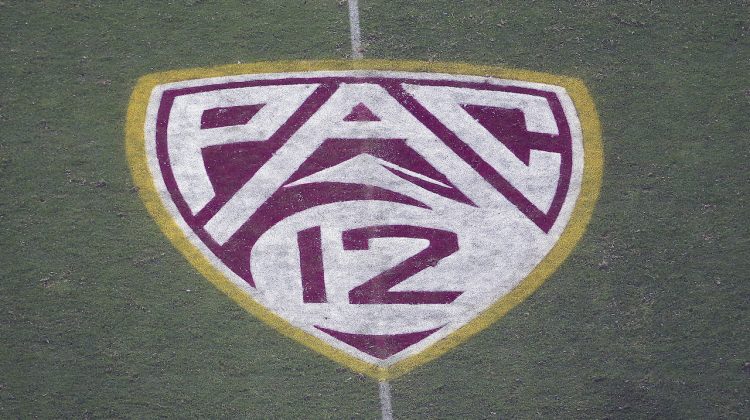Seven-and-a-half months into its existential crisis, the Pac-12 doesn’t have a media rights contract, hasn’t decided whether to expand and is offering public pronouncements of unity from the university presidents — all while rumors of its pending demise are rampant.
The middle of February feels an awful lot like the beginning of July.
And in many respects, nothing has changed for the conference since those roiling weeks that followed the announced departures of USC and UCLA to the Big Ten.
Then as now, ESPN and Amazon are likely distribution partners.
Then as now, expansion (by two) is a distinct possibility.
Then as now, the most likely outcome to this saga is the continued existence of the Pac-12 with a media rights deal that extends through the end of the decade.
There are no guarantees until the 10 university presidents sign the grant-of-rights agreement that binds their media rights revenue to the conference.
But despite all the events of the past seven months that seemingly have nudged the Pac-12’s Doomsday Clock toward midnight, the myriad forces at work in realignment (both internal and external) still point toward the schools moving forward together.
Following the spate of media reports last week suggesting commissioner George Kliavkoff misread the market and is struggling to generate competitive bids, the Hotline was asked if our Pac-12 survival odds have been adjusted downward.
For several months, we have listed survival as a 5.5-point favorite over extinction — less than a touchdown.
That’s up from 4.5 points last summer, immediately after the thunderbolt from L.A. But at no time in the past seven months has the number exceeded 5.5 points, which carries an implied probability of approximately 65 percent.
And we aren’t lowering it now.
Why? Because the threats and obstacles to Pac-12 survival currently in the news have been baked into the line.
Consider:
Even though the expanded College Football Playoff adds legitimacy to the regular season and stability to the Power Five structure …
Even though the Big Ten presidents didn’t have the appetite for additional expansion and the Big Ten media partners didn’t have the money to create a western division with Oregon, Washington and the Bay Area schools …
Even though the Big 12, in a play for stability, signed a below-market deal with ESPN and Fox, limiting the revenue opportunities for Utah, Colorado and the Arizona schools …
And even though Big Ten commissioner Kevin Warren, the primary proponent of further raids, left his post for a gig with the Chicago Bears …
The survival odds never exceeded 5.5 points.
Here’s why: As the Power Five landscape appeared to move in the Pac-12’s favor, time worked against the conference.
Every week that passed without a media agreement added an incremental element of risk — the potential for unknowns to delay or derail the process.
Unknowns, like an economic downturn hitting Big Tech in December.
Unknowns, like Disney cutting $5.5 billion in costs, thereby impacting ESPN’s ability to pay for content.
Unknowns, like Comcast claiming $50 million in overpayments to the Pac-12 Networks that began years ago under former commissioner Larry Scott.
All along, the Hotline has used back-of-the-napkin equation to help frame Pac-12 survival probability:
D x PX + (B12-IA) – B10X + ESPN5 – T2 = P12S
By which …
D: The inherent desire of the 10 schools to stick together.
PX: The immense structural stability offered by playoff expansion.
B12: The threat posed by the Big 12, which accounts for both the media rights revenue ($31.7 million per school per year) and the lack of a full pro-rata clause in the deal with ESPN and Fox.
IA: Lack of institutional alignment between Pac-12 and Big 12 schools (political, cultural and academic).
B10X: The threat of additional Big Ten expansion, which is currently near zero.
ESPN5: ESPN’s preference for five stable conferences and belief that college football is best as a regional sport. (“The amount of time we spend thinking about market size pales in comparison to the amount of time we think about rivalries,” ESPN president Burke Magnus told the ‘Marchand and Ourand’ podcast last summer.)
T2: Time squared, representing unknown risks.
P12S: Pac-12 survival
Midway through February, where do things stand? Essentially unchanged. The door to the Big Ten is closed, the expanded playoff is looming and the schools still don’t have a reason to jump, en masse, to the Big 12.
ESPN and Amazon are bidding on Pac-12 rights, according to multiple sources in the sports media space. And we believe (but haven’t confirmed) that Apple is interested, as well, along with either CBS or Turner.
We also believe the revenue piece will equal or exceed that of the Big 12. The reconfigured conferences were similar in value last summer and are similar in value today.
(The challenge for Kliavkoff isn’t revenue; nobody is changing conferences over a few million dollars per year. The key is securing comparable revenue and reasonable exposure — the Pac-12’s premium football games must be on linear broadcast networks.)
When will it end? When will we know the Pac-12’s fate?
Our unofficial deadline is the middle of March.
If an acceptable deal isn’t secured by the start of the NCAA Tournament — to be clear: that could be a formal contract or an agreement in principle — then the schools will get anxious and our odds for Pac-12 survival will drop.
Until then, the Hotline’s outlook remains unchanged.
*** Send suggestions, comments and tips (confidentiality guaranteed) to pac12hotline@bayareanewsgroup.com or call 408-920-5716
*** Follow me on Twitter: @WilnerHotline
*** Pac-12 Hotline is not endorsed or sponsored by the Pac-12 Conference, and the views expressed herein do not necessarily reflect the views of the Conference.
Related posts:
 Wilner Hotline – Thanksgiving Day Pac-12 Doings
Wilner Hotline – Thanksgiving Day Pac-12 Doings

Oklahoma head coach Lincoln Riley . (AP Photo/Jeffrey McWhorter)
Wilner Hotline – Lincoln Riley To USC Sends Shock Waves Through Pac-12
(AP Photo/Marcio Jose Sanchez)
Business of Sports-Pac-12 media rights: Kliavkoff expects critical process to stretch into 2023
Arizona head coach Adia Barnes (AP Photo/Tony Avelar)
Metcalfe Pac-12 WBB notebook: Stanford sweeps ranked LA schools, Utah splits despite Pili injury, Arizona back in bye position

